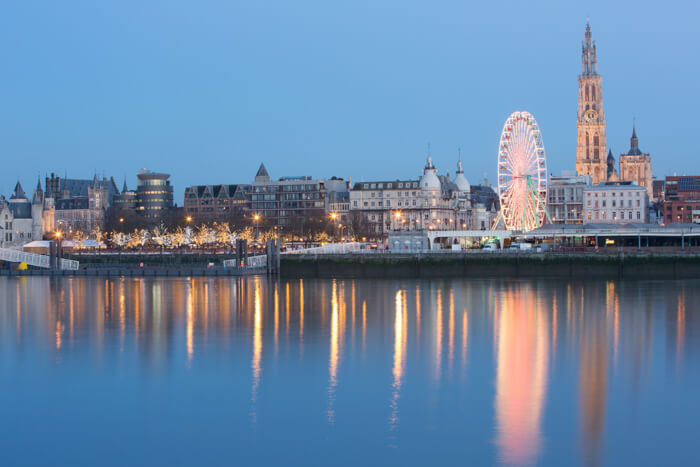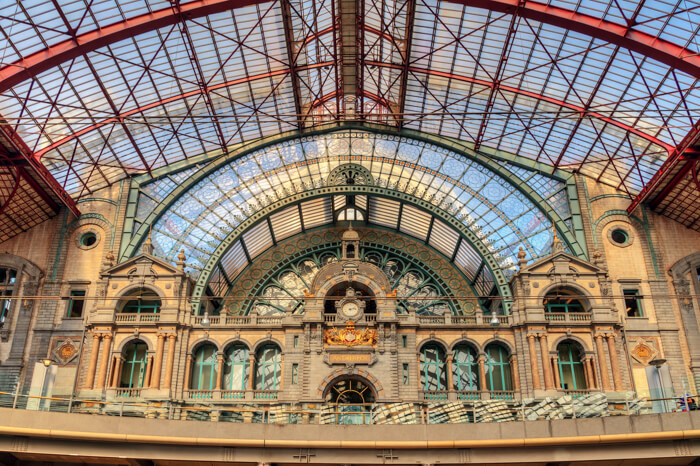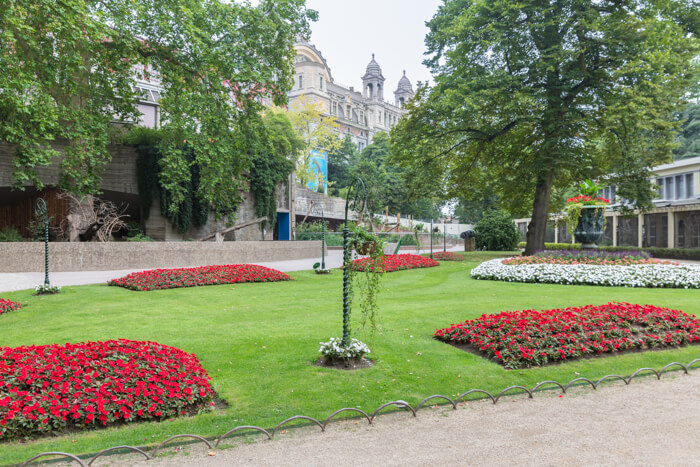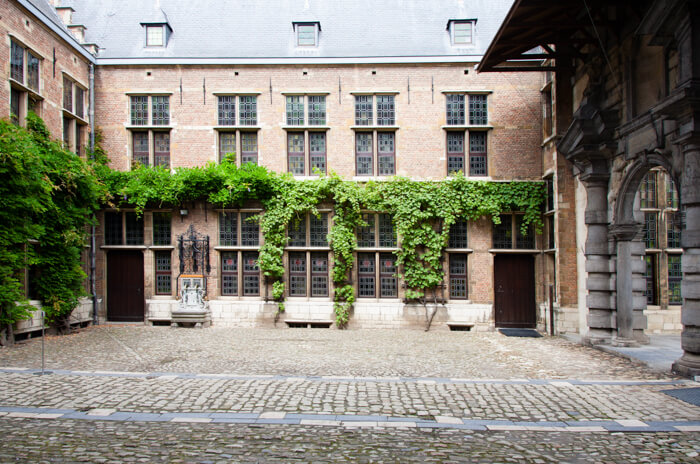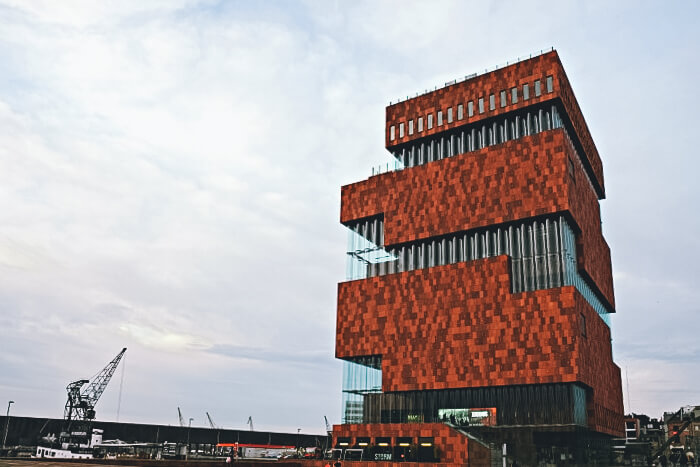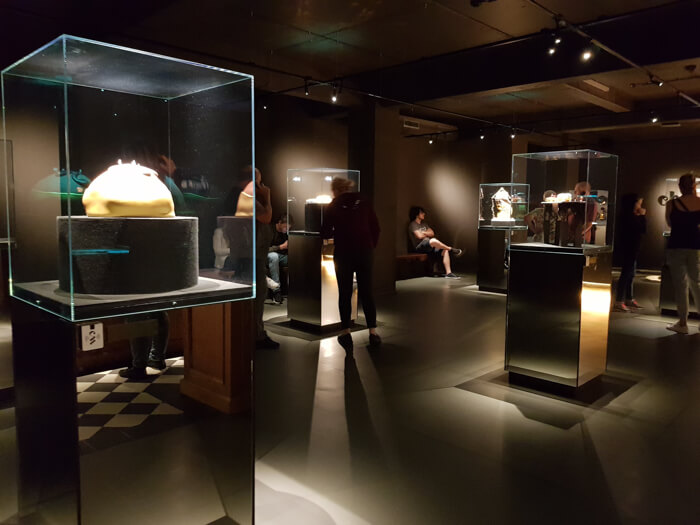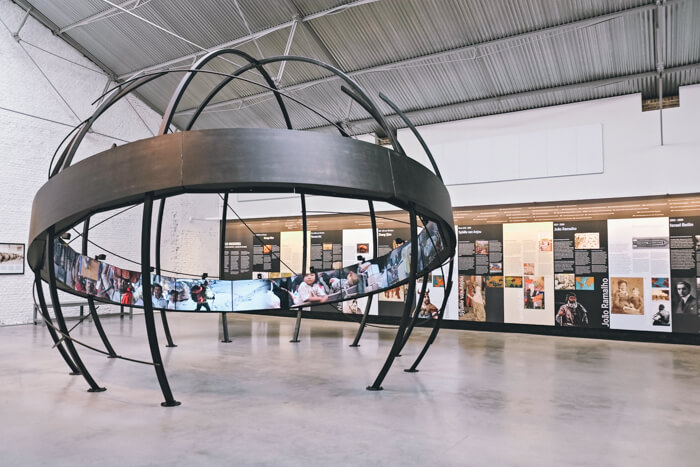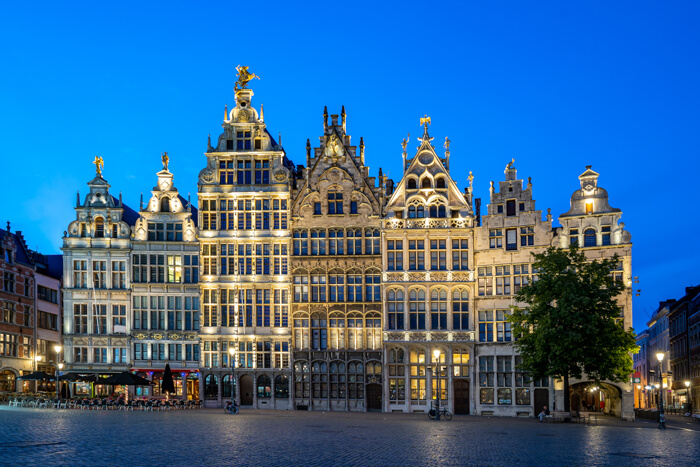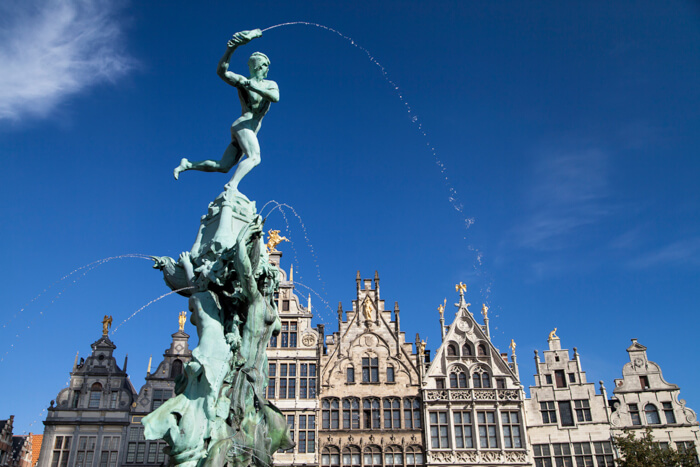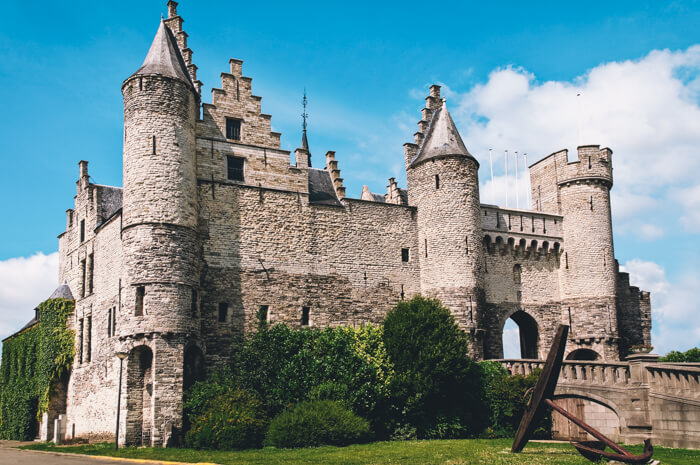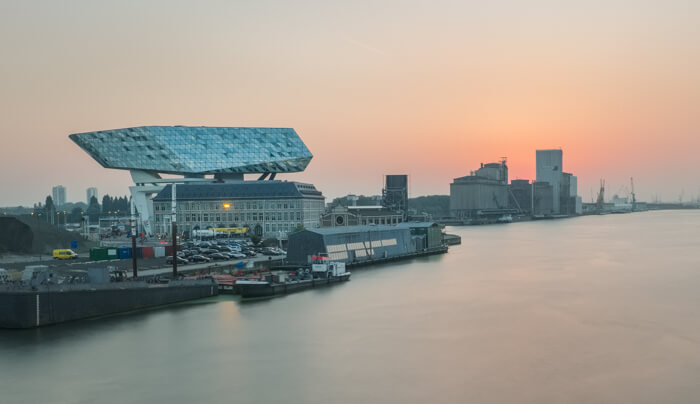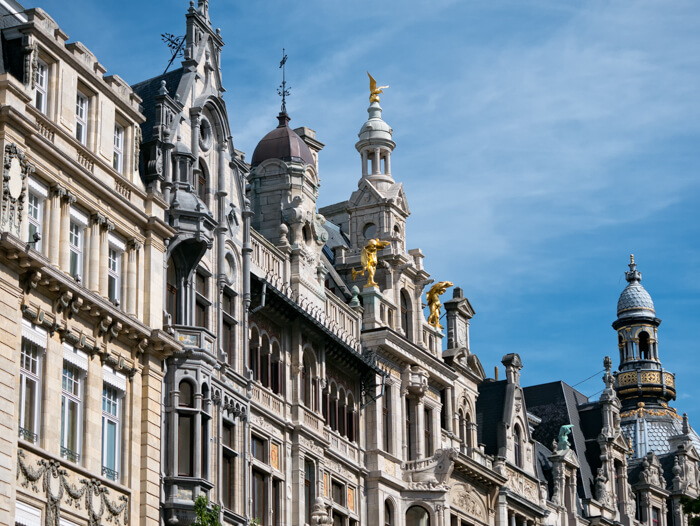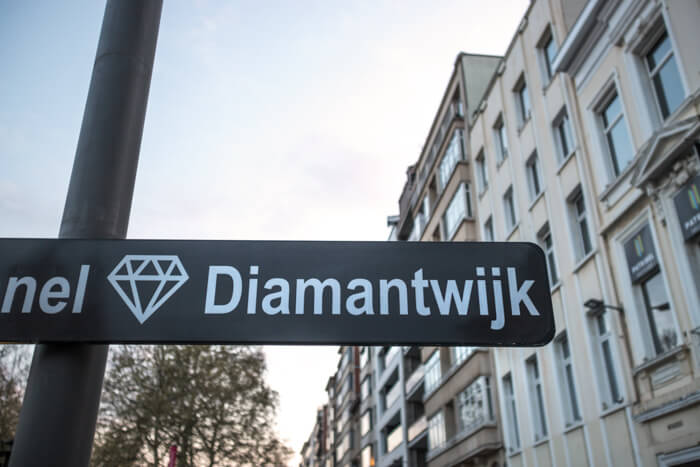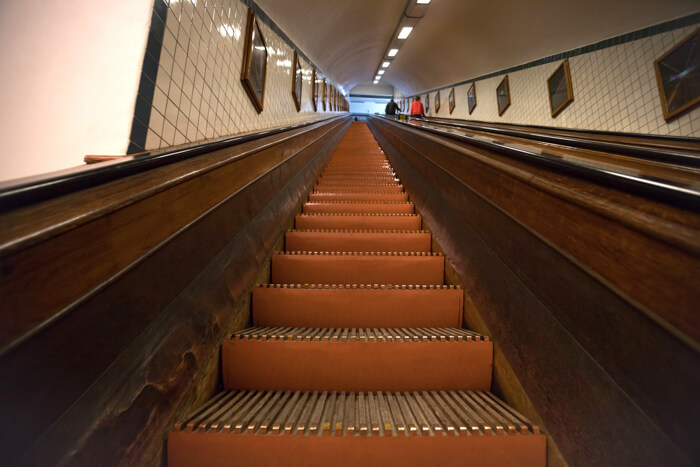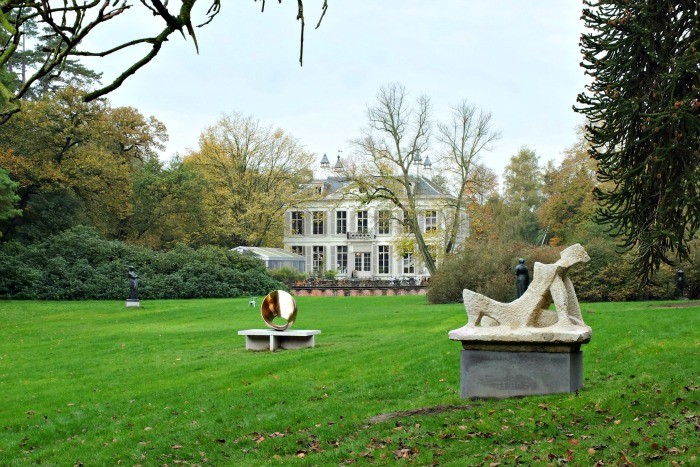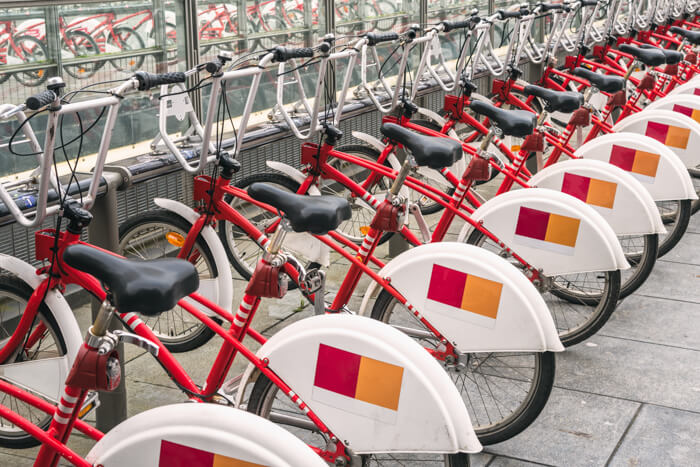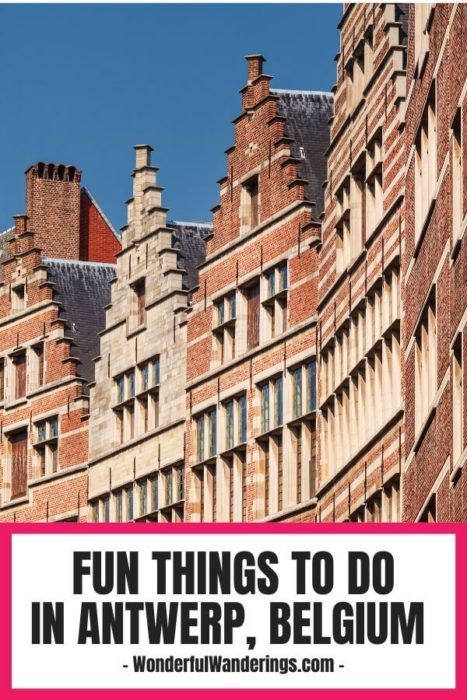Known as Belgium’s “capital of cool”, “city of diamonds” and “city of fashion”, the attractions in Antwerp are endless.
The reason why there are so many things to do in Antwerp is down to the city’s wealthy past. Found only 15 km (9 miles) south of the Dutch border, it lies on the River Scheldt which links it to the North Sea which has historically made it a hugely important port.
Around 400 years ago, Antwerp was among the most prosperous cities in Europe. At that time, its strategic position meant that its status rose until it became the second-largest European city north of the Alps.
Today it’s known for its diamonds, fashion and art scene. Not to mention its amazing coffee shops! It's definitely one of the hippest cities in Belgium
Read on for just a sample of things to do in Antwerp, from exploring its spectrum of architecture and museums to delving into its boutique shops. If you only have one day in Antwerp, you might have to close your eyes and pick a random selection from the list below!
- Gawp at Antwerp Central station. Antwerp Central station is a grand train station incorporating different architectural styles like Neo-Renaissance and Art Nouveau. Its massive steel platform roof towers 43 meters high.
- See the exhibits at Museum Vleeshuis. Museum Vleeshuis is a music museum inside the Butchers' Hall building. It has interactive displays of instruments and exhibits on printing's role in Antwerp's music.
- Pay a visit to Antwerp Zoo. Antwerp Zoo is one of the world's oldest zoos with an impressive variety of animals and themed enclosures like an Egyptian temple.
- Grab a bite at the Saturday Exotic Market. Saturday Exotic Market is a weekly open-air market selling international ingredients, spices, crafts and food.
- Wander through Rubens House. Rubens House is the former home and studio of painter Peter Paul Rubens, now a museum with period furnishings.
- Enjoy the Antwerp Botanical Garden. Antwerp Botanical Garden covers 10 hectares with over 6,000 plant species like rare orchids and roses.
- Trace 400 years of printing at the Plantin-Moretus museum. Plantin-Moretus Museum is set in a printing dynasty's residence with workshops, artifacts and a library of 25,000 texts.
- Visit the Royal Museum of Fine Arts. Royal Museum of Fine Arts exhibits a large collection of paintings, sculpture and tapestries spanning the 14th to 20th centuries.
1. Gawp at Antwerp Central station
For a true taste of grandeur, there’s no better place to spend time than Antwerp Central Station (also known as the Middenstatie). A great big structure of glass, steel and marble, the central station is one of the city’s most treasured sites.
Belgium was the first European country to open a public railway back in 1835 and Antwerp was a major part of this early infrastructure. The original wooden terminus was replaced by this grand station over a ten year period between 1895 and 1905.
Antwerp’s train station incorporates several different architectural styles making it hard to describe. The facade is Neo-Renaissance in style but with elements of Art Nouveau here and there – designed by architect Louis Delacenserie. You can see why Antwerp Central Station is frequently mentioned among the world’s most beautiful stations.
To really get a feel for the building, however, you need to step inside (or even better, arrive by train!). First, you’ll reach the main entrance hall with its impressive staircase and ornate station clock.
Keep going and a huge 43-meter high ceiling steel platform roof created by engineer Clement van Bogaert towers above you. It was built especially high to accommodate for all the steam train smoke. This roof itself tells a story – that of countless bombings in World War II and if you look carefully you can still see a bend in the ceiling.
Thankfully Belgium wasn’t ready to give up on this spectacular building. After multiple restorations and expansions, today’s station has four levels (two of which are underground) and plays a vital role in the country’s modern-day rail network.
2. See the exhibits at Museum Vleeshuis
Museum Vleeshuis stands as the heartbeat of Antwerp's musical and cultural narrative. Nestled within the iconic Gothic edifice of the “Butchers' Hall”, this museum is more than a repository of artefacts; it's a living testament to the city's vibrant history. Every corner of Museum Vleeshuis resonates with the melodies of instruments that span over six centuries, from the delicate notes of harpsichords to the robust tones of bagpipes.
The museum's “Antwerp Hands” exhibit is not just a display but a tribute to the city's unparalleled craftsmanship, especially the revered art of bell casting. As visitors traverse Museum Vleeshuis, they're not just spectators; they become participants, thanks to the museum's interactive displays. Engaging with virtual carillons or trying one's hand at a replica instrument, the museum ensures every exhibit is a tactile experience.
Museum Vleeshuis also chronicles the pivotal role of the printing press in shaping Antwerp's musical legacy. The delicate manuscripts and music sheets whisper tales of bygone eras, revealing how music was not just played but felt and lived. The museum's ever-evolving temporary exhibitions ensure that Museum Vleeshuis remains a dynamic space, always offering fresh insights into the world of music, from age-old folk tunes to avant-garde sound art.
The very walls of Museum Vleeshuis tell tales of the Butchers' Guild's prominence, with its redbrick façade standing tall and proud. Every brick, every ornate detail, is a silent witness to the city's rich past. And for those who seek a deeper connection, the museum's guided tours offer a treasure trove of stories, painting a vivid picture of Antwerp's musical journey.
Strategically located amidst other cultural landmarks, Museum Vleeshuis is not just a destination but an essential chapter in the city's cultural odyssey. It's where history, art and innovation converge, captivating music aficionados, history buffs and wanderers alike. In essence, a visit to Museum Vleeshuis is not just a tour; it's an immersive experience, a symphony that encapsulates the very essence of Antwerp.
3. Pay a visit to Antwerp Zoo
When Antwerp Zoo was built back in 1843 it stood outside the main city walls. It shows just how much Antwerp has expanded around it since then as today, the 10 ha / 25-acre site is in the city center, standing right next to the central station in today’s old town.
This isn’t just any zoo. It’s one of the oldest zoos on Earth and the oldest in Belgium. It was officially listed as a monument in 1983. Architecturally it’s a visual treat, with its Art Deco entrance and themed enclosures. There is an Egyptian temple for the elephants and giraffes, a thatched cottage housing a koala couple, an aquaforum for the sea lions, a Moorish temple for the okapis and a pink villa for the hippopotami.
It’s considered one of the best zoos in the world because of its breeding program and amazing variety of creatures – from king penguins to caimans, jaguars to marmosets, aardvarks to spectacled owls. It’s proud to house over 7000 animals of 950 different species. The care and space the animals are given are regarded as top quality too.
Antwerp Zoo also puts on some fantastic events. There’s a series of talks hosted by the zoo each day and in the winter an annual festival called China Light takes place on the zoo grounds. This is an amazing spectacle of light sculptures that tells ancient folk tales from China and features traditional music and Chinese dances. Not to miss if you’re in Antwerp in the winter season!
For a panoramic perspective, guests can hop on the zoo's miniature railway. Antwerp Zoo ensures a memorable experience, captivating animal enthusiasts young and old.
4. Grab a bite at the Saturday Exotic Market
Saturday Exotic Market, located outside Sint-Jansplein in Antwerp, is a vibrant hub of culture and commerce. Every Saturday, this bustling market comes alive, offering a plethora of exotic spices, international ingredients and unique handicrafts. As visitors navigate the market, they encounter stalls brimming with spices like cumin, turmeric and cinnamon sourced from countries such as India, Turkey and Morocco. Dried chiles, available in various colors and intensities, catch the eye, while rare baking ingredients beckon culinary enthusiasts.
Saturday Exotic Market isn't just about shopping; it's a gastronomic adventure. Guests can savor hot arepas, empanadas or a plate of currywurst while relaxing at the available picnic tables. Thirsty? The market offers refreshing options like fresh-squeezed sugar cane juice and creamy mango lassi.
But it's not all about food. Saturday Exotic Market also showcases vibrant scarves, handcrafted baskets and other artisanal products. The air, filled with the rhythm of world music and the chatter of diverse languages, transports visitors on a global journey without leaving Antwerp. Both locals and tourists cherish this weekly tradition, making Saturday Exotic Market an essential Antwerp experience.
5. Wander through Rubens House
Rubens House serves as both a time capsule and a vivid tableau, capturing the essence of Rubens' life and work. Each room is a chapter in the story of Rubens, adorned with period-appropriate furniture, paintings and tapestries that the artist himself chose. From the gallery room, which served as Rubens' personal exhibition space, to the intricately carved dining room where he hosted the era's elite, Rubens House is a comprehensive showcase of the artist's lifestyle and creative process.
The house also offers a rare window into the Flemish Baroque era through Rubens' collection of New World artefacts. But perhaps the heart of Rubens House is the artist's studio. Painstakingly restored to its original condition, the studio is filled with the tools and pigments that fueled Rubens' artistic genius.
Since his death, the house has passed through numerous pairs of hands, even becoming a prison at one point after the French Revolution. Eventually, the City of Antwerp acquired the building in 1937 and managed to restore it to its former glory. Now you can wander through the ten refurbished rooms and imagine what life might have been like for one of the most influential Flemish artists.
The gardens of Rubens House, too, are an extension of the artist's palette, teeming with the tulips and roses that are often featured in his still-life works. As you wander through this historic estate, you're not just observing—you're participating in the world that Rubens created and that, in turn, created so many masterpieces. Rubens House isn't just an attraction; it's an essential pilgrimage for understanding the monumental legacy of Peter Paul Rubens.
6. Enjoy the Botanical Garden
The Botanical Garden in Antwerp offers a serene escape amidst urban hustle. Spanning 10 hectares, this garden showcases over 6,000 plant species, tracing its roots back to 1825 before relocating in 1930. Botanical Garden features distinct zones: the arid house teems with cacti and succulents, while a Victorian-style greenhouse bursts with tropical flora. Visitors can meander through formal rose gardens, wildflower meadows and ponds dotted with lilies.
Under the canopy of tall trees, benches invite relaxation. Meandering paths lead past vibrant flower beds and sculptures, introducing both native Belgian flora and rare species from continents like Africa and Asia. Botanical Garden's commitment to conservation shines, championing endangered plant preservation. Informative signs delve into the garden's diverse botanical treasures and seasonal exhibits add to its allure. Whether you're a plant aficionado, a nature lover or just seeking tranquillity, Botanical Garden promises a refreshing retreat.
7. Trace 400 years of printing at the Plantin-Moretus museum
Plantin Moretus Museum in Antwerp stands as a beacon of printing and publishing heritage. Located in the ancestral residence of the Plantin Moretus printing dynasty, this museum unravels 400 years of typographic evolution in Europe. Christophe Plantin, who founded the publishing house in 1555, spearheaded industry transformations through groundbreaking techniques and artistic ventures. Visitors to Plantin Moretus Museum witness the age-old charm of workshops where traditional letterpress printing brought texts to life. The museum proudly displays original 16th-century printing presses, typesets and tools, offering a tangible connection to the past.
Venturing deeper into the museum, guests discover historic living spaces and a vast library housing over 25,000 texts. This treasure trove encompasses illuminated manuscripts, early print editions and invaluable archives, shedding light on subjects ranging from religion and science to art. The museum also showcases maps, sketches, artworks and sculptures linked to the family's renowned publications. Periodic exhibits further delve into the printing evolution across the continent. Plantin Moretus Museum, with its rich tapestry of history, is a must-visit for bibliophiles and those intrigued by the legacy of book production.
8. Visit the Royal Museum of Fine Arts
The Royal Museum of Fine Arts in Antwerp stands as a treasure trove of art spanning the 14th to 20th centuries. Nestled within an imposing structure, this museum showcases a vast array of exhibits. Flemish masters such as Rubens, Van Dyck and Jordaens illuminate the legacy of the Antwerp School of painting. Visitors can trace the evolution of regional techniques and styles through ecclesiastical art, portraits, still lifes and landscapes. The museum also boasts Renaissance tapestries, detailed silverwork and period furniture, reflecting the craftsmanship of the 16th and 17th centuries. A dedicated sculpture gallery presents marble and bronze creations, while the Magritte collection offers a deep dive into Surrealism.
Key pieces include Rubens' powerful “The Descent from the Cross” and his captivating sketches. The portraits by Van Dyck and Jordaens capture intricate expressions and fabric details. Surrealist enthusiasts can ponder over Magritte's iconic pieces like “The Son of Man” and “The Treachery of Images”. Royal Museum of Fine Arts invites guests on a comprehensive journey through Antwerp's rich artistic heritage, ensuring an immersive experience for all.
9. Take a photo from the roof of the MAS Museum Aan de Stroom
MAS Museum Aan de Stroom dominates Antwerp's skyline with its modern, red-brick architecture. Located on the Schelde River, this art museum offers a rooftop observation deck for panoramic city views. Dutch architect Neutelings Riedijk designed the building, making it a photography subject in its own right. Once inside, an elevator whisks visitors to the rooftop, revealing 360-degree vistas of Antwerp.
From this height, the cathedral spires and historic city center come into focus. The deck also offers views of the labyrinthine streets, guild houses and Baroque buildings. Far off, cranes and shipping containers signify Antwerp's role as a major port. Looking east, the River Scheldt stretches into the horizon. The changing light and weather conditions offer photo opportunities during both day and night. However, visitors should secure loose items; the winds at this elevation can be strong. MAS Museum Aan de Stroom serves as a dynamic platform for capturing Antwerp's ever-changing landscape.
10. Try the samples at Chocolate Nation
Chocolate Nation in Antwerp is a haven for chocolate enthusiasts. Situated near the Grand Place, this museum delves into Belgium's renowned chocolate legacy. Visitors embark on a sensory journey, starting from a simulated rainforest where cacao trees thrive. Expert chocolatiers showcase their craft, tempering chocolate and crafting pralines with finesse. For those eager to try their hand, workshops allow guests to create their own chocolate masterpieces.
Interactive exhibits trace chocolate's roots, its global journey and intricate production methods. A collection of vintage moulds, ads and packaging offers insights into chocolate's historical branding and design. The experience culminates in a room brimming with truffles, ganaches and other chocolate-coated delights. A tasting platter awaits, allowing guests to indulge in an array of flavours. To round off the visit, Chocolate Nation's café and restaurant serve up delectable desserts and cocoa-inspired dishes.
11. Follow the migration trail through the Red Star Line Museum
The Red Star Line Museum is totally unique, telling the compelling story of over 2.5 million migrants that left Europe for hopes for a better life in North America. This mass emigration took place between 1873 and 1934 on the ships of the Red Star Line company.
The Red Star Line Museum in Antwerp captures the city's pivotal role in migration history. Situated in the original warehouses of the Red Star Line shipping company, the museum chronicles the transatlantic voyages between Antwerp and America during the late 19th and early 20th centuries. It offers visitors a glimpse into the experiences of over 2 million passengers. Inside, one can step onto recreated platforms, experience a ship cabin replica and hear genuine emigrant stories of hope and departure.
The exhibits showcase various reasons for migration, from economic struggles to religious oppression. They also depict the emotional toll of leaving loved ones, illustrated by spaces like a police inspection room. Notable travellers, such as Albert Einstein and Irving Berlin, are highlighted, emphasising their journeys through Antwerp. The museum candidly addresses the era's inequalities, including the stringent U.S. entry quotas for specific groups. Red Star Line Museum paints a vivid picture of how migration influenced both Europe and the U.S., offering a profound understanding of the aspirations and challenges faced by those seeking a fresh start.
12. Visit the Cathedral of Our Lady
The Cathedral of Our Lady is the tallest building in Antwerp, situated in the heart of the city’s old town. It’s also proud to be the largest Gothic cathedral in the low countries, with an enormous bell tower. This breath-taking belfry is 123 meters (404 feet) tall.
Construction on the cathedral began in 1352 and took a massive 169 years to complete. It wasn’t until 1521 that the building was finally finished and a number of influential architects took over the project during its construction.
It’s quite something to go and marvel at from the outside, but if you can, get a ticket to visit Antwerp Cathedral’s interior, too. This is where you’ll see some of the most beautiful Baroque decors, with seven aisles in total, alongside works by Antwerp’s beloved artist Peter Paul Rubens.
13. Grab a drink on the Grote Markt
Grote Markt stands as Antwerp's vibrant core, framed by ornate guild houses, the iconic City Hall and the Brabo Fountain. This bustling square draws both locals and tourists to its many cafés and bars. Day or night, Grote Markt promises a drink for every preference.
From its outdoor terraces, visitors can appreciate the square's ambiance, watch street performers or admire the surrounding architectural gems. Belgian beer lovers will delight in the diverse offerings, from renowned Trappist ales to unique craft beers. Wine enthusiasts and spirit seekers aren't left out; many establishments serve a curated range, including the local jenever, a traditional Belgian gin.
Grote Markt is more than a place for drinks; it's a hub of social activity. Regular festivals, markets and events amplify its lively spirit. In winter, the square becomes enchanting, adorned with lights, hosting a Christmas market and ice skating rink. Sipping on hot chocolate or mulled wine adds warmth to the festive atmosphere.
Its central location, near attractions like the Cathedral of Our Lady and the Museum PlantinMoretus, makes Grote Markt a strategic stop for city explorers. Here, visitors don't just drink; they immerse in a tradition that cherishes community and camaraderie. Grote Markt embodies Antwerp's hospitality, offering a taste of the city's essence with every sip.
14. Stand in front of the Brabo Fountain
Brabo Fountain, prominently positioned in Antwerp's Grote Markt, is more than just a monument; it's a reflection of the city's rich folklore and identity. This iconic structure narrates the tale of the hero Silvius Brabo, who bravely defeated the giant Antigoon. Legend says Antigoon demanded tolls from those crossing the river Scheldt and cut off the hands of those who declined. The fountain captures Brabo's victory, showing him ready to hurl the giant's severed hand into the river.
Crafted by Jef Lambeaux in 1887, every detail of Brabo Fountain, from Brabo's fierce expression to the base's intricate design, showcases the period's exceptional artistry. As visitors approach, they're enveloped by the square's vibrant atmosphere, surrounded by historic guild houses, bustling cafés and the grand City Hall. The fountain's water jets add a lively touch, shimmering under daylight and glowing under nighttime illumination.
Photographers and tourists alike are drawn to its captivating design, making it a favorite spot for memorable snapshots. Guided tours around Grote Markt often spotlight the Brabo Fountain, diving deep into its legend, craftsmanship and importance to Antwerp's residents. The city's name itself is believed to originate from the Dutch “hand werpen”, translating to “throw a hand”, linking back to Brabo's tale.
Visiting Brabo Fountain isn't just a touristy endeavor; it's an immersion into a legend, an art appreciation session and a bond with Antwerp's cultural tapestry. It stands as a testament to Antwerp's enduring spirit, creativity and heritage, beckoning everyone to uncover the story shaping the city's essence.
15. Chill at Steen Castle
Steen Castle, overlooking the River Scheldt in Antwerp, is a harmonious blend of history and relaxation. This fortress, characterized by its sturdy walls and round tower, transports visitors to a bygone era while offering a serene escape.
The name “Steen” translates to “stone” in Dutch, aptly describing its robust structure. A unique statue of a giant with two humans greets visitors at the entrance, infusing the place with a hint of folklore. Inside, the calm courtyard, adorned with cobblestones and gardens, beckons exploration. Strategically placed benches offer spots to relax and admire the river and city views.
Het Steen used to be a much bigger fortress and was historically important in controlling the river Scheldt. Today’s castle dates back to the early 1200s, but there have been fortresses on this site as far back as 645. Like several castles in Belgium, it spent part of its existence as a prison.
The terrace of Steen Castle is a favoured relaxation spot, offering outdoor seating with panoramic views. Here, visitors can savour a drink or meal amidst the castle's historic ambiance, complemented by the gentle river breeze. But the castle isn't just about leisure; it's a portal to Antwerp's maritime past. The National Maritime Museum, nestled within its walls, delves into the city's maritime connections, displaying artefacts from ship models to navigational tools.
Conveniently located near the city's heart, Steen Castle is a cherished retreat for both locals and tourists. It occasionally hosts events like concerts, adding vibrancy to its serene setting. The castle's rich history, combined with cultural events, ensures it remains a lively attraction. Photographers will find the castle's architecture and surrounding nature a treasure trove of shots, from the sunlight on its walls to the river's reflections.
Visiting Steen Castle is more than just a leisurely activity; it's an immersion into a space rich with history and nature. It stands as a testament to Antwerp's enduring spirit, its maritime heritage and offers a tranquil space for reflection. Whether you're a history enthusiast, an architecture admirer or someone seeking a peaceful spot, Steen Castle promises a diverse experience, connecting visitors with the very soul of Antwerp.
16. Take in some of Antwerp’s architecture hotspots
Because of Antwerp’s historic status as an important merchant port, it’s understandably home to some beautiful buildings that reflect its former grand position in the world. We’ve already dropped in on the Gothic Cathedral of Our Lady, the 17th-century Rubenshuis, the pioneering Antwerp Central Station and the grand guild houses of the Grote Markt among others. There’s a heap of further design delights to make architecture fans drool.
A trip to see the old Butcher’s Hall (Vleeshuis) is worthwhile. Strangely church-like in structure, this building was purpose-built during Antwerp’s Golden Age. A red brick and white sandstone building constructed in the early 16th century for the central city meat market, it had room for 62 of the city’s butchers to trade and use as headquarters. The interlaced red and white brickwork is known locally as “bacon layers”.
Take a stroll down Cogels-Osylei in Zurenborg for a glimpse into the former lives of the Belgian bourgeoisie. This street is renowned for its crazily eclectic selection of Belle Epoque mansions built in the late 19th and early 20th centuries. Architects vied for attention with decadent houses in a complete spectrum of styles, from Art Nouveau to Tudor, Neo-Gothic, to Neo-Classical.
For a taste of the modern side of Antwerp, the Port House couldn’t be a better stop for your itinerary. This glass behemoth on the city’s skyline came about after a challenge for Zaha Hadid Architects to transform an old protected fire station. The structure towers over the old building and its mirror-like exterior bounces light around the port, a reference to Antwerp’s famed diamonds.
17. Go fashion shopping in Antwerp
Antwerp is celebrated for its fashion scene and in Belgium and further afield it is known as the “city of fashion”. In Antwerp, you’ll find the Fashion Academy, the Flanders Fashion Institute and MOMU, the Fashion Museum. Unsurprisingly, it’s also globally famous for shopping.
Shoppers flock from all over the country and beyond to visit Meir street, Antwerp’s main shopping street. It's one of the main Antwerp tourist attractions and probably a good destination if you’re short on time or want to dedicate just one day to shopping. This area between Antwerp Central Station and the Cathedral of Our Lady is home to all the international brands, not to mention some gorgeous architecture.
This is also where you’ll find De Stadsfeestzaal, a spectacular luxury shopping complex in the restored festival hall with a dramatic golden dome, mosaic floor and impressive marble staircase.
If vintage gems are more your style, head to the Kloosterstraat for retro and antique furniture, clothing, trinkets and things. For some more designer and boutique shopping, you should check out Schuttershofstraat, Kammenstraat, Lombardenvest and the area around the central Groenplaats.
18. See the diamond-cutters at work in the Diamond District
The Diamond District sits prominently in Antwerp, solidifying the city's title as the “diamond capital of the world”. Spanning several blocks, this radiant hub showcases the intricate journey of diamond transformation. As you stroll through its streets, the shimmering diamonds in storefronts highlight the district's primary trade. A visit to a workshop in the Diamond District unveils the meticulous art of diamond cutting. Here, diamantaires or diamond cutters, transform rough stones into brilliant gems.
Diamond cutting is a craft demanding precision, patience and a discerning eye. Diamantaires employ specialised tools to enhance a diamond's inherent shine. A raw diamond, though precious, doesn't possess the finished gem's radiance. But under a skilled cutter's touch, it reveals its concealed splendour. Each facet and cut is deliberate, aligning with the diamond's innate traits. The Four Cs —Carat, Cut, Clarity and Colour — guide this transformation. Tours often delve into Antwerp's diamond legacy, the diamond's voyage from extraction to sale and the nuances of cutting.
Beyond crafting, the Diamond District is a trading epicentre. The Antwerp Diamond Exchange, the planet's oldest, buzzes with transactions and trades. For buyers, the district's showrooms present an array of jewellery and gems, with experts aiding in selecting the ideal piece.
The Diamond District isn't merely a tourist spot; it's a tribute to craftsmanship, a nod to beauty and a window into an industry integral to Antwerp's essence. Whether you're a jewellery aficionado, a keen traveller or a gemology enthusiast, the district promises a layered experience. It's where rough diamonds attain elegance, where expertise meets artistry and where the diamond's charm is magnified by masterful hands. The Diamond District stands as a luminous emblem of Antwerp's rich legacy.
19. Taste some of the local beer
Local beer culture in Antwerp is a testament to Belgium's rich brewing legacy. Here, one can savor traditional brews like the renowned “Bolleke” or explore cosy beer cafés adorned with classic wooden decor. Antwerp offers guided brewery tours, shedding light on the intricate beer-making process and hosts beer festivals that honor Belgium's brewing prowess. Many restaurants in the city incorporate beer into their culinary offerings, suggesting beer-food pairings, while specialty shops stock a diverse range of bottled beers for enthusiasts.
In Antwerp, the local beer culture extends beyond just drinking. It encompasses unique glassware, precise pouring methods and a burgeoning craft beer movement that champions both innovation and eco-friendliness. Beer in this city isn't merely a drink; it symbolises centuries-old heritage, meticulous craftsmanship and a taste that embodies Antwerp's essence. For both beer aficionados and eager explorers, the city's beer scene promises a deep dive into tradition, camaraderie and fervour.
20. Go bargain-hunting at one of Antwerp’s markets
Antwerp’s markets are a treasure trove of unique finds and vibrant atmospheres. Grote Markt, located in the city's core, operates daily, showcasing a diverse array of items from fresh flowers and local produce to Belgian chocolates and apparel. As you shop, the historic guild halls around the square enhance the experience. Rommelmarkt Nationalestraat, the city's renowned flea market, comes alive on weekends. Here, vendors display a mix of antique furniture, jewellery, art and various curiosities. For antique enthusiasts, the Old Market (Oudemarkt) is a must-visit on weekends. This market boasts a collection of Flemish paintings, silverware, chandeliers and vintage linens. Beyond shopping, Antwerp’s markets also offer delicious food stalls and the chance to discover lace goods, a nod to the city's lace-making heritage. Engaging in friendly haggling is part of the charm, ensuring visitors secure the best deals in these bustling marketplaces.
21. See the activity at the Port of Antwerp
The Port of Antwerp stands as a testament to maritime prowess and activity. Visitors can embark on boat tours along the Scheldt River, gliding by cranes and massive container ships, showcasing the port's vast operations. The MAS museum's observation deck offers panoramic views of the docks and the ceaseless movement of vessels. Inside the historic Steen Castle, exhibits trace the port's transformation into Europe's second-largest. Het Pomphuis restaurant, once a pump house, offers diners scenic port views. A drive through the Kennedy Tunnel unveils the expansive port lands, filled with warehouses, railroads and shipping containers ready for global transport. Experiencing the Port of Antwerp's infrastructure and bustling activity offers a glimpse into its 500-year legacy as a maritime powerhouse.
22. Walk through St. Anna’s Tunnel
St. Anna’s Tunnel (or Sint-Annatunnel) is a bit of a unique phenomenon and another one of the many things to see in Antwerp. In brief, it’s a deep, long tunnel that was established in the 1930s, that runs from one side of the river to the other. Before the tunnel’s construction, people had to use a ferry service to get from one side of Antwerp to the other.
Town planners did consider constructing a bridge as the city expanded, but it was decided that a bridge would limit the travel of Antwerp’s important ships up the river, so a tunnel was opted for instead.
The main feature isn’t really the tunnel itself, but the magnificent wooden escalators that take you down over 30 meters / 98 feet underground. These unusual wooden escalators would have been a novelty when they were built back in the 30s and today they remain pretty special.
Like most places, the tunnel was damaged severely in World War II but after restoration work, the escalators and tunnel itself is still very much in use and is the recommended way to get from riverbank to riverbank when traveling about Antwerp.
23. Browse Meir Shopping Street
Meir Shopping Street stands as Antwerp's vibrant heart for fashion and urban energy. Nestled in the city's core, Meir boasts a diverse shopping landscape, from luxury designer outlets to beloved high street names. The street's architecture, a harmonious blend of Baroque, Rococo and Neoclassical styles, adds to its allure. Shoppers can find everything from contemporary trends to classic staples. The Stadsfeestzaal, a luxurious shopping centre with marble interiors and a grand dome, offers an upscale shopping experience.
Beyond shopping, Meir pulses with life. Street performers, outdoor cafés and the scents of Belgian treats create a lively atmosphere. Notable landmarks like the Royal Palace and Bourla Theatre enrich the street's cultural offerings. As a pedestrian-friendly zone, Meir ensures a relaxed shopping journey. Seasonal events, from festive Christmas lights to summer sales, enhance its appeal.
Exploring Meir Shopping Street is an immersion into Antwerp's cosmopolitan essence and its rich fashion legacy. It's where shopping meets art, history and city life. For shoppers, architecture enthusiasts or those soaking in the city's ambiance, Meir promises a comprehensive experience, encapsulating Antwerp's diverse charm.
24. Middelheim's sculpture park
Middelheim's sculpture park in Antwerp's suburbs melds art and nature seamlessly. Spanning 30 hectares, this open-air museum boasts over 200 sculptures, from renowned artists like Auguste Rodin to innovative contemporary creators. Established in 1950, the park offers a visual journey through various artistic eras. Sculptures sit amidst green lawns, forests and ponds, enhancing the natural beauty.
Different sections of the park cater to varied artistic tastes. “Middelheim High” displays grand pieces, while “Middelheim Low” focuses on smaller, intricate works. The connecting “Nachtegalen Park” offers a picturesque route for visitors. Those keen on understanding the art's depth can opt for guided tours, which delve into the sculptures' history and inspiration. Annual events and exhibitions introduce new artworks and perspectives.
As seasons change, Middelheim's sculpture park transforms, with nature accentuating the art's beauty. It's a family-friendly space, with interactive pieces and open areas for kids. For those looking to unwind, picnic spots and a café are available. The park stands as a testament to the harmonious blend of art and nature, offering visitors a unique, immersive experience.
25. Tour the city by bike
Antwerp’s not a huge city when it comes to exploring and one of the best ways to travel is definitely with two wheels. You can get from one neighborhood to another pretty quickly from Het Zuid to Het Eilandje, for example, it is less than 4 km (2.5) miles.
There are 700 km (435) miles of cycle lane in Antwerp and in general cyclists are treated well and certainly as equals to the motorized traffic. Bike tours are available too if you want to explore Antwerp in a different light.
There’s a city-wide bicycle rental scheme called VeloAntwerpen which is easy to use, with over 100 stations throughout the city. You just purchase a membership card online, through the app or in-person at the office and then use a code to unlock a bike for 30 minutes travel at a time. There’s a brilliant app for this service where you can find available stations and see if they’re full up or not.
26. Pop into St Paul’s Church
St Paul’s Church in Antwerp offers a serene escape from the city's hustle. Built between 1617 and 1634, this former Dominican establishment showcases a stunning Baroque interior. As visitors enter, they're immediately captivated by the ceiling's intricate floral designs and sculptures, a hallmark of the Baroque style.
St Paul’s Church houses masterpieces by Antwerp's renowned artists, including Rubens, Jordaens and Francken. Their paintings, adorning the nave, bring biblical tales to life with vivid colours and detailed compositions. As sunlight streams through the tall windows, it illuminates the church's beauty, allowing visitors to immerse themselves in the artistic legacy of Antwerp's Baroque period.
What is the best time to visit Antwerp?
The best time to visit Antwerp is widely considered from May through September. During these months, the weather is pleasantly warm with average temperatures between 20-25°C (68-77°F). The summer season brings the most sunshine and driest weather. However, July and August also draw peak tourist crowds. To avoid the summer rush while still enjoying nice weather, late spring and early autumn are ideal. May, June, September and October offer comfortable temperatures and fewer tourists, meaning better availability for hotels and activities. The weather is changeable year-round though, so rain can happen anytime. Winters are chilly with more rain and very little sunshine. While December hosts lively Christmas markets, January and February see the coldest temperatures. Overall the warmest and sunniest periods with comfortable weather and fewer crowds make late spring through early fall the best time for most visitors to experience Antwerp.
What is the weather like in Antwerp?
Antwerp typically has a marine west coast climate with mild temperatures year-round. Summers are comfortable and partly cloudy while winters are long, cold, windy and mostly cloudy. July is the hottest month in Antwerp with average highs of 23°C and average lows of 14°C. January is the coldest month with average highs of 5°C and average lows of 1°C. Antwerp gets precipitation spread throughout the year with average rainfall ranging from 18mm to 57mm per month. December sees the most rainy days at 18.7 days on average while September has the fewest at 11.7 rainy days. Antwerp can get snowfall, especially in December which averages 31mm. Daylight hours in Antwerp range from 8 hours in December to 16.5 hours in June. Antwerp gets an average of 3.7 to 9.4 hours of sunshine per day depending on the month. Humidity levels tend to stay stable year-round, averaging between 73% and 87%. Wind speeds average between 9 mph in August to 17 mph in February. Late spring through early autumn are pleasant times to visit Antwerp.
What are the best museums in Antwerp?
Listed below are the best museums in Antwerp, Belgium.
- The Plantin Moretus Museum: This museum showcases the history of book printing and typography, offering insights into Antwerp's role as an important port city.
- FOMU Antwerp: FOMU Antwerp is a photography museum that features various exhibitions, including “Shooting Stars” by Jan Hoek and “Masterpieces and Discoveries” by August Sander.
- The Red Star Line Museum: The Red Star Line Museum tells the story of the Red Star Line, a shipping company that transported millions of immigrants to the United States. It offers a glimpse into the experiences of those who embarked on this journey.
- Muhka: Muhka is a contemporary art museum that showcases a diverse range of artworks, including paintings, sculptures, installations and multimedia pieces.
- The Rubens Museum: Dedicated to the works of the renowned Flemish painter Peter Paul Rubens, this museum houses a vast collection of his paintings and provides insights into his life and artistic career.
These museums in Antwerp offer unique and enriching museum experiences for visitors to explore the art, history and culture of Antwerp
What is the Antwerp Christmas market?
The Antwerp Christmas market is a festive event that takes place during the holiday season in Antwerp, Belgium. It is a lively and bustling market where visitors can immerse themselves in the holiday spirit. The market stretches across various squares in the city, including Groenplaats, Handschoenmarkt, Grote Markt, Suikerrui and Steenplein. Here, you will find around 100 stalls offering a variety of goods, including delicious food, warm winter accessories, crafts and Christmas items. The market is also known for its iconic Ferris wheel at Steenplein, which provides a stunning view of the river Schelde and the Steen fortress. The Antwerp Christmas market is a must-visit for those seeking a festive and joyful atmosphere during the holiday season.
What are the best hotels to stay in Antwerp?
Listed below are the best hotels to stay in Antwerp:
- Sapphire House Antwerp, Autograph Collection: Sapphire House Antwerp is part of the Autograph Collection and offers a luxurious and unique experience in the city's heart. The hotel's design is inspired by the city's rich diamond heritage, with elegant interiors reflecting modern sophistication and timeless elegance. Guests can enjoy top-notch amenities, including a gourmet restaurant, a spa and well-appointed rooms, making it an ideal choice for leisure and business travellers seeking comfort and style. Sapphire House Antwerp, Autograph Collection is considered one of the best hotels to stay in Antwerp.
- Botanic Sanctuary Antwerp – The Leading Hotels of the World: Botanic Sanctuary Antwerp is a member of The Leading Hotels of the World and offers an oasis of tranquillity and luxury. The hotel is known for its exquisite design, blending classic architecture with contemporary touches and its commitment to sustainability and wellness. With a world-class spa, fine dining options and impeccable service, Botanic Sanctuary provides a serene and indulgent escape for those looking to experience the best of Antwerp in an elegant setting.
- Maison Nationale City Flats & Suites: Maison Nationale City Flats & Suites offers a unique and boutique accommodation experience in the vibrant fashion district of Antwerp. The property combines an apartment's privacy and space with a hotel's services and amenities, making it perfect for extended stays or those seeking a HomeAway from home atmosphere. Each flat and suite is thoughtfully designed with modern décor, fully equipped kitchens and comfortable living spaces, providing a convenient and stylish base for exploring the city's attractions, shopping and dining.
What are the best restaurants in Antwerp?
Listed below are the best restaurants in Antwerp:
- The Jane: The Jane is a Michelin-starred restaurant located in a renovated chapel, offering a truly divine dining experience. Led by known Chef Sergio Herman, the restaurant's menu is a creative fusion of modern European cuisine, prepared with precision and flair. The stunning interior, designed by Piet Boon, features a dazzling chandelier and stained glass windows, creating an ambience that is both elegant and dramatic, making The Jane a must-visit destination for food connoisseurs.
- Mojo: Mojo is a popular seafood restaurant located in Antwerp, Belgium. It is known for serving high quality, fresh seafood like oysters, lobster, sole, and cod. Reviews praise the bouillabaisse, fried shrimp croquettes, and fresh grilled fish. The atmosphere is relaxed and service friendly. Mojo has decently priced wine options. While there can be delays when busy, reviewers on TripAdvisor rate Mojo highly, giving it 4.5 stars out of 5 and a Traveler’s Choice award in 2022 for its tasty dishes and fresh seafood.
- SELSation: SELSation is a family-run restaurant that prides itself on offering a warm and personalised dining experience. The menu, crafted by Chef Jan Sels, focuses on Belgian and French classics, prepared with a modern touch and a deep respect for seasonal and local produce. The cosy and inviting ambience and attentive service make SELSation an ideal choice for those looking to enjoy traditional flavours in a relaxed and friendly setting.
What are the best coffee shops and bars in Antwerp?
Listed below are the best coffee shops and bars in Antwerp:
- Dogma: Dogma is a cocktail bar quickly becoming a favourite among locals and visitors for its innovative and expertly crafted cocktails. Located in a cosy and atmospheric space, the bar's interior exudes a vintage charm, with dim lighting and classic décor. The bartenders at Dogma are true artisans, creating bespoke cocktails that cater to individual tastes, making it a perfect spot for those seeking a sophisticated and personalised drinking experience.
- Jones & Co: Jones & Co is a modern and stylish bar that offers a wide selection of spirits, cocktails and wines. Known for its friendly and knowledgeable staff, the bar provides a relaxed and welcoming atmosphere where guests can explore new flavours and classic favourites. With regular events, tastings and a commitment to quality, Jones & Co has established itself as a go-to destination for those looking to enjoy a lively evening with friends in a chic and contemporary setting.
- Beerlovers Bar: As the name suggests, Beerlovers Bar is a haven for beer enthusiasts, offering an extensive selection of local and international craft beers. With over 30 beers on tap and hundreds more in bottles, the bar allows one to explore craft beer's rich and diverse world. The laid-back ambience, communal seating and passionate staff make Beerlovers Bar a must-visit for anyone looking to discover new brews, enjoy classic ales and engage in friendly conversation with fellow beer lovers.
What are the best castles to visit in Belgium other than Steen Castle of Antwerp?
Belgium is home to some truly remarkable castles that showcase its rich history and architectural heritage. There are Gravensteen Castle, Bouillon Castle, Modave Castle, Veves Castle and Beloeil Castle.
One of the most impressive castles in Belgium is Gravensteen Castle in Ghent, a medieval fortress dating back to the 12th century. Its well-preserved structure and panoramic views of the city make it a must-visit. Bouillon Castle, located in the town of Bouillon, is another gem. Perched on a rocky hill overlooking the Semois River, it offers guided tours that delve into its medieval past. Modave Castle, nestled in the picturesque Ardennes region, is a stunning example of Renaissance architecture. Visitors can explore its opulent interiors and beautiful gardens while enjoying the surrounding countryside. Veves Castle, near Dinant, is like something out of a fairy tale. With its blend of architectural styles and lush green surroundings, it's a captivating sight. Lastly, Beloeil Castle, often referred to as the Belgian Versailles, is a grand estate in the province of Hainaut. Its elegant interiors, beautiful gardens and hosting of cultural events throughout the year make it a must-see. These castles offer a glimpse into Belgium's fascinating past and are sure to leave visitors in awe.
PIN FOR LATER

